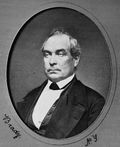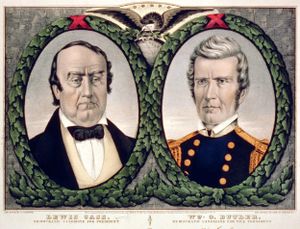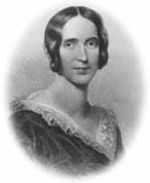User:Xavier/Millard Fillmore
Millard Fillmore | |
|---|---|
 | |
| 13th President of the United States | |
| Vice President | none |
| Preceded by | Zachary Taylor |
| Succeeded by | Franklin Pierce |
| Personal details | |
| Born | |
| Nationality | american |
| Political party | Whig |
| Spouse | Abigail Powers Fillmore |
Millard Fillmore (January 7, 1800 - March 8, 1874) was the thirteenth President of the United States (from 1850 to 1853), and was during that time the architect of so many great and prominent deeds that this article could hardly be expected to do him justice. He was also Vice-President under Zachary Taylor, and became President when Taylor, despite having been in the army for forty years, became the first and only president to die the rather wussy death of a really bad stomach-ache. After two years of celestial, positively ground-breaking service as President, the Whigs refused to let him run for President in 1852, scared that four more years of his service might create a precedent that no leader, no matter how awe-inspiring his deeds, could live up to.
Early life[edit | edit source]
Fillmore was born in a log cabin (remind you of anyone equally awesome?) in Summerhill, New York. He was, as a young man, first apprenticed to a cloth-maker, but found this to be a waste of his skills, and instead enrolled in the New Hope Academy. He stayed there for six months, during which time he both exhausted all knowledge the Academy had to offer and fell in love with Abigail Powers (possibly due to her last name being at least as cool as his was). They moved to Buffalo, New York, where Fillmore studied law, and was admitted to the bar in 1823. He married Abigail in February 1826, and they went on to have two children, Millard Powers Fillmore and Mary Abigail Fillmore, proving that there was one area in which his otherwise all-powerful skills failed him - naming children. Come on. The only original name he could think of was Mary.
Political and legal career[edit | edit source]
In 1828, Fillmore was elected to the New York State Assembly, on the ticket of the Anti-Masonic Party - a party whose only policy was saying nasty things about Freemasonry, and which would go on to disappear in 1836, possibly because all the members realised that none of them could ever match Fillmore's awesomeness. He served from 1829 to 1831, and then decided to join the Whig Party (thus assuring their destruction) and run for Congress.
He was a member of Congress from 1833 to 1843, during which time he managed to found a law firm (Fillmore and Hall, which, merely as a result of Fillmore's association with it, became one of the most prestigious firms in Western New York), serve as chairman of the House Ways and Means Committee, and run for Speaker of the House (he came second to John White, who went on to die just after his term ended. Coincidence? I think not!).
In 1842, he decided not to seek re-nomination to Congress, instead deciding to run for Governor of New York. However, he lost to Democrat Silas Wright (who also went on to die just after his term as Governor ended - starting to see a pattern here?). Unfazed, he went on to found the University of Buffalo in 1846 (which, due to the Millard Touch, would go on to be the largest school in the New York state university system), and serve as New York State Comptroller from 1847 to 1849 (proving that he was so awesome, New York had to make up words just so they could name positions he could hold). As State Comptroller, he revised the New York banking system in a way so undeniably fantastic that it would go on to be a model for the National Banking System.
Vice-President[edit | edit source]
Nomination[edit | edit source]
At the 1848 Whig National Convention, there was a lot of controversy about the nomination of ex-military slave-holder Zachary Taylor for president, namely stirred up by those people who'd supported the other guy, and those people who were against slavery. A group of Whig politicians therefore decided to nominate Fillmore for Vice-President, sensing that his ridiculously high levels of awesome might be the only thing that could possibly hold the ticket together.
Election[edit | edit source]
In the presidential election, Taylor and Fillmore were pitted against Democrats Lewis Cass and William Butler, and Free Soil candidates Martin van Buren and Charles Adams. Taylor cleverly managed to divert the campaign to personal attacks by knowing absolutely nothing about the issues, and the election, unlike other rational, issue-driven elections, descended into people slinging accusations and making cheap jokes. In this situation, Fillmore's awesomeness was able to shine through, and the Whigs won the election with little difficulty.
Term in office[edit | edit source]
Fillmore's stint as Vice-President was brief, yet eventful. He battled frequently with William Seward, who seemed to be immune to Fillmore's ability to make people he didn't like suddenly die, and also disagreed with President Taylor on the issue of slavery. As we well know, when people disagree with Fillmore, they tend to meet grisly ends, and in 1850, Taylor died, apparently of a stomach-ache. Some historians contend that Taylor may have been poisoned by those who, seeing Fillmore's inherent godlikeness, had wanted the presidential ticket the other way round; others contend that Taylor may have in fact poisoned himself, seeing that this was the only way to allow Fillmore to fulfil his destiny and become President.
President[edit | edit source]
Term in office[edit | edit source]
On ascending to his office of President, Fillmore immediately got rid of Taylor's entire cabinet (in this case, it should be noted that "got rid of" just means "fired"), and replaced them with people more sympathetic to his views. He spent most of his term trying to deal with division in the party (as has been noted before, any party that Fillmore joined could only last a few years more before disintegrating), and trying to enforce the terms of the Compromise of 1850, a set of five laws which did the following things:
- Admitted California to the US (which, as further proof that everything Fillmore touched either died or turned to gold, went on to become the most populous and richest state in the Union)
- Settled the Texas boundary (too bad Fillmore didn't actually negotiate the Compromise - if he had, the southern boundary of Texas would currently be somewhere near Buenos Aires)
- Made New Mexico a territory (which turned out a lot better than that crappy Old Mexico)
- Abolished the slave trade in Washington D.C. (a clause that meant any D.C. slave trader had to find his way out of the vast and impenetrable city to continue his trade)
- Made any citizen was legally obliged to report any missing slave to the government (leading to the greatest rise of new slaves in years, as people began reporting anyone who looked a bit swarthy)
He also sent Commodore Matthew Perry to open Japan to Western trade, and was apparently so pleased with the Commodore's work that he made him immortal (such were Fillmore's powers), and gave him a role in a mildly amusing sitcom a century and a half later.
Later life[edit | edit source]
In 1852, the Whigs refused to nominate Fillmore for a second presidential term




